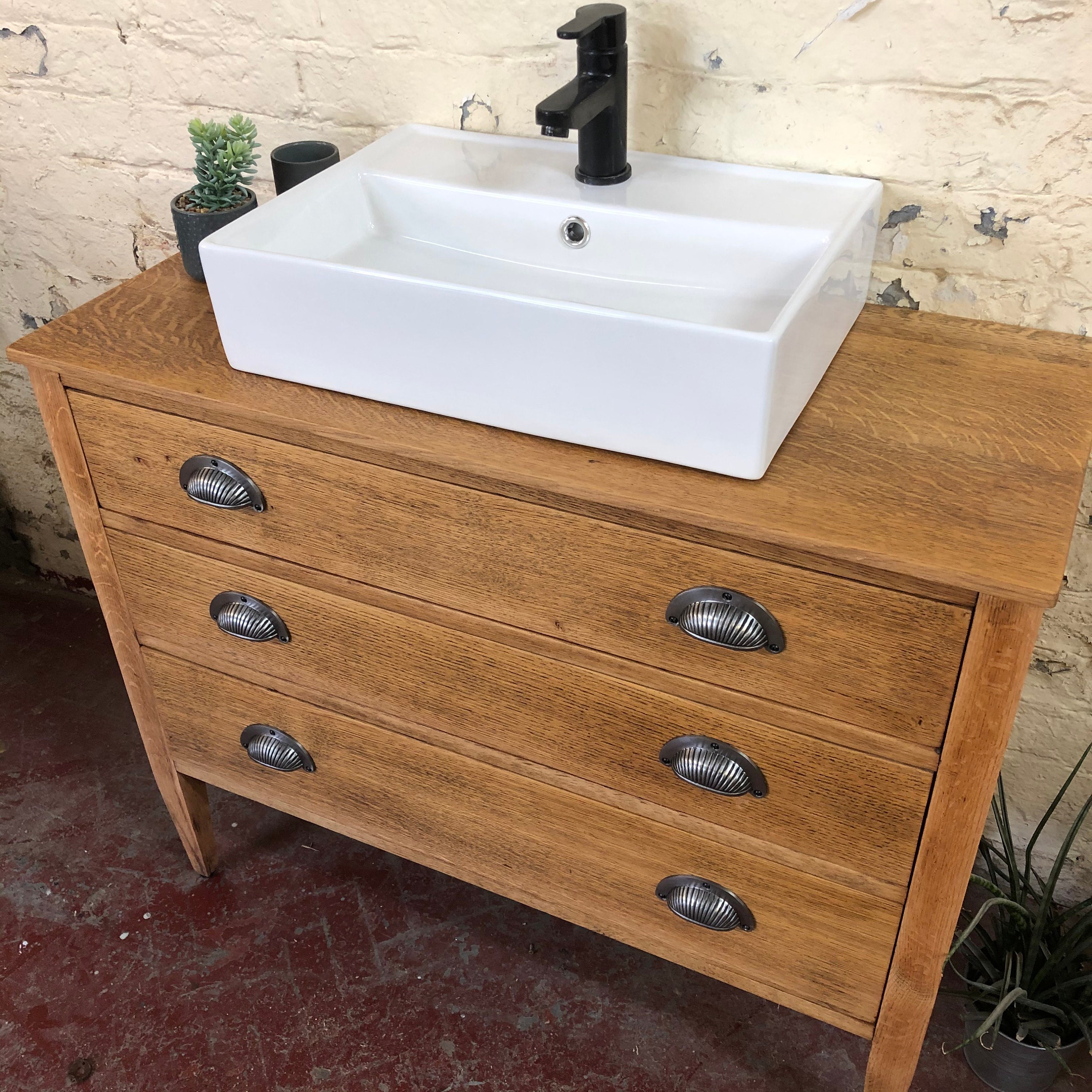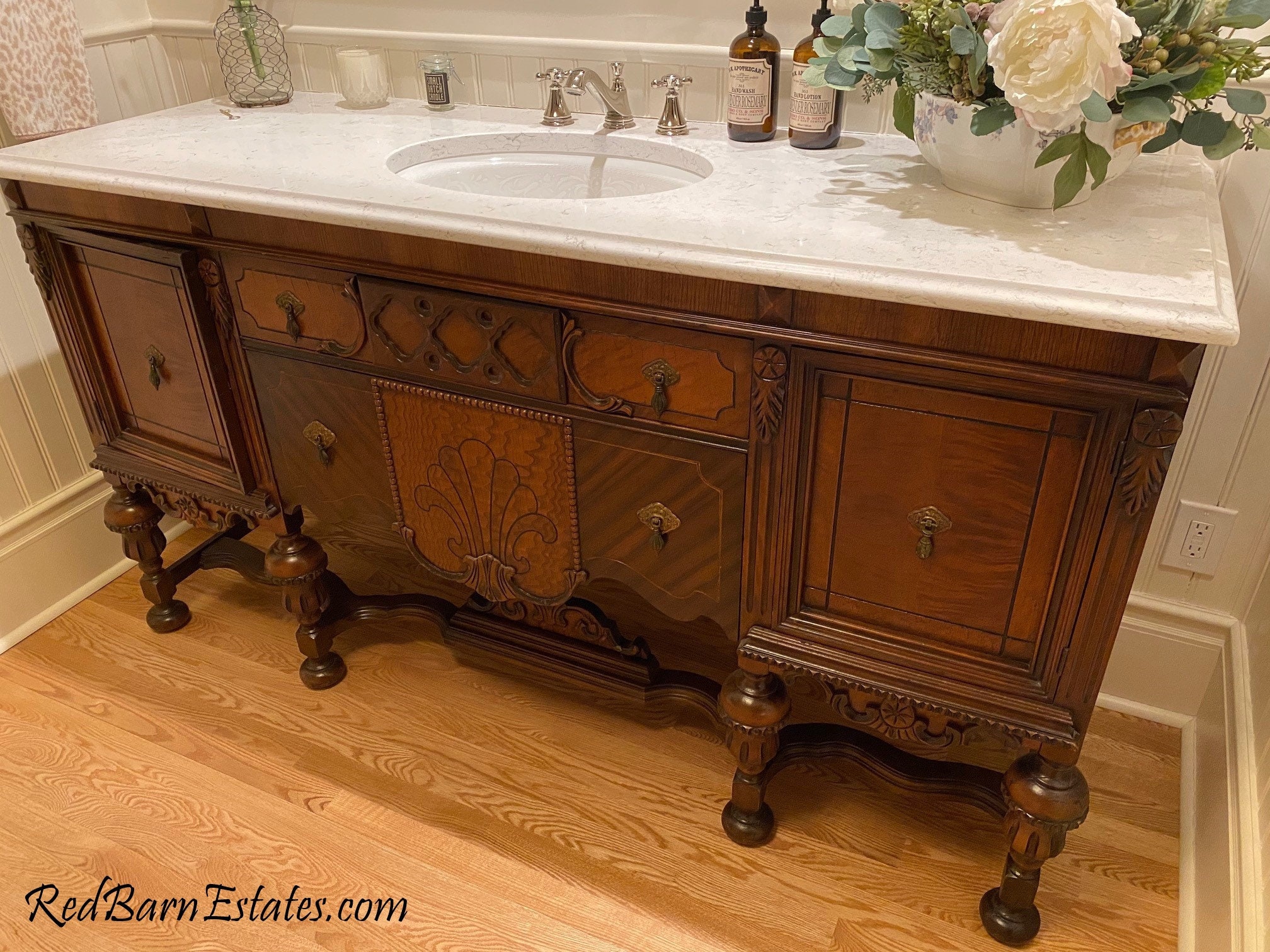Antique Cabinet Bathroom Vanity

Antique cabinet bathroom vanities are a testament to the enduring appeal of classic design and craftsmanship. These timeless pieces blend functionality with aesthetic elegance, transforming bathrooms into havens of refined style. They seamlessly integrate historical elements with contemporary needs, offering a unique blend of charm and practicality.
Historical Significance and Evolution
Antique cabinets have a rich history, evolving over centuries to meet changing needs and tastes. Their origins can be traced back to ancient civilizations, where cabinets were used for storage and display. In the 18th and 19th centuries, the rise of craftsmanship and cabinetmaking led to the development of intricate and ornate cabinets, often made from exotic woods and adorned with intricate carvings and embellishments. The evolution of the bathroom as a dedicated space for personal hygiene in the late 19th and early 20th centuries spurred the adaptation of antique cabinets for bathroom use. These early bathroom vanities were often simple in design, but they showcased the craftsmanship and materials that characterized the era.
Antique Cabinet Styles
Antique cabinets come in a wide array of styles, each reflecting a specific historical period and design aesthetic.
- Victorian Era (1837-1901): Victorian-style cabinets are known for their elaborate ornamentation, often featuring intricate carvings, scrollwork, and decorative hardware. They are typically made from dark woods like mahogany or walnut and often have a rich, dark finish.
- Art Nouveau (1890-1910): Art Nouveau cabinets embrace flowing, organic lines and motifs inspired by nature. They often feature stylized floral designs, geometric patterns, and curved forms. They are typically made from lighter woods like oak or maple and may have a lighter, more natural finish.
- Art Deco (1920s-1930s): Art Deco cabinets are characterized by geometric patterns, bold colors, and luxurious materials. They often feature geometric shapes, stylized animals, and metallic accents. They are typically made from exotic woods like ebony or rosewood and may have a high-gloss finish.
- Mid-Century Modern (1940s-1960s): Mid-century modern cabinets emphasize clean lines, simple forms, and functionality. They often feature minimalist designs, with a focus on natural materials like wood and metal. They may have a natural or stained finish.
Materials and Craftsmanship
Antique cabinets are typically made from high-quality materials, showcasing the craftsmanship and artistry of the era.
- Wood Types: Common wood types used in antique cabinet construction include mahogany, walnut, oak, cherry, and maple. Each wood has unique characteristics in terms of grain, color, and durability.
- Finishes: Antique cabinets often feature intricate finishes, such as hand-rubbed oil finishes, shellac, lacquer, or paint. These finishes enhance the beauty of the wood and provide protection against wear and tear.
- Hardware: Antique cabinet hardware is often made from brass, bronze, or iron and features intricate designs and finishes. These details add a touch of elegance and sophistication to the overall design.
Craftsmanship and Artistry
The craftsmanship involved in creating antique cabinets is truly remarkable. Skilled artisans employed traditional techniques, such as hand-cutting, carving, and joinery, to create pieces that were both beautiful and durable.
“The craftsmanship of antique cabinets is a testament to the skill and artistry of the past. Each piece is a unique work of art, reflecting the dedication and passion of the artisans who created it.”
Integrating Antique Cabinets into Modern Bathrooms

The charm of antique cabinets can effortlessly transform a modern bathroom into a haven of timeless elegance. Their intricate details, rich finishes, and unique character add a touch of history and sophistication to contemporary spaces. Integrating antique cabinets into modern bathroom designs requires careful planning and consideration to create a harmonious and stylish ambiance.
Designing a Bathroom Layout with an Antique Cabinet as a Vanity
When incorporating an antique cabinet as a vanity, it’s essential to choose a design that complements the overall bathroom layout and aesthetic. Antique cabinets come in various styles, sizes, and configurations, so selecting one that fits the available space and bathroom design is crucial.
- Consider the size and shape of the cabinet. A large antique cabinet may be ideal for a spacious bathroom, while a smaller one might be better suited for a smaller space. The cabinet’s shape can also influence the layout, with a rectangular cabinet providing a more traditional feel and a round or oval cabinet adding a touch of whimsy.
- Determine the placement of the cabinet. The antique cabinet should be positioned in a way that allows for easy access and functionality. Consider placing it against a wall, in a corner, or as a freestanding element. The placement should also consider the location of plumbing and electrical outlets.
- Think about the flow of traffic in the bathroom. The antique cabinet should not obstruct the movement of people or impede access to other fixtures.
Restoring and Maintaining Antique Bathroom Cabinets: Antique Cabinet Bathroom Vanity

Breathing new life into an antique cabinet and incorporating it into your bathroom requires a careful restoration process. This section will guide you through the essential steps to restore an antique cabinet for bathroom use, highlighting the importance of choosing the right cleaning and preservation methods to ensure its longevity and beauty.
Restoring Antique Cabinets for Bathroom Use
Restoring an antique cabinet for bathroom use involves a meticulous approach that balances preserving its historical character with adapting it for modern functionality. Here’s a comprehensive guide:
- Assessment and Planning: Begin by assessing the cabinet’s condition, identifying areas requiring restoration. Consider the cabinet’s overall structure, wood type, finish, and any existing damage. This initial evaluation helps determine the necessary steps and resources for restoration.
- Cleaning and Preparation: Thoroughly clean the cabinet to remove dirt, dust, and grime. Use a soft cloth and a mild cleaning solution appropriate for the cabinet’s finish. Avoid harsh chemicals that can damage the antique wood or finish. For stubborn stains, consult with a professional conservator.
- Repairing Damage: Address any structural damage, such as cracks, loose joints, or missing pieces. Consult with a professional woodworker or restoration specialist for guidance on appropriate repair techniques. Use wood fillers or glues compatible with the cabinet’s material and finish.
- Refinishing: If the original finish is damaged or worn, consider refinishing the cabinet. Stripping the existing finish may be necessary, followed by sanding and applying a new finish that is compatible with the bathroom environment. Consider using water-based polyurethane or oil-based finishes that provide moisture resistance and durability.
- Modernization: Adapt the cabinet for bathroom use by adding features like a sink, faucet, storage shelves, and hardware. Choose fixtures and materials that complement the cabinet’s style and create a cohesive design. Consider adding a countertop with a moisture-resistant material like granite or quartz.
Selecting Cleaning and Preservation Methods, Antique cabinet bathroom vanity
The longevity and beauty of an antique cabinet depend on using appropriate cleaning and preservation methods. Consider the following:
- Dusting: Regularly dust the cabinet using a soft, dry cloth or a feather duster to remove dust and debris. Avoid abrasive materials that can scratch the surface.
- Cleaning: For cleaning, use a mild, pH-neutral cleaner specifically designed for antique furniture. Avoid harsh chemicals, abrasive cleaners, or excessive moisture that can damage the finish.
- Polishing: Apply a high-quality furniture polish designed for antique wood to protect the finish and enhance its shine. Use a soft cloth and apply the polish in a thin, even layer.
- Humidity Control: Maintain a consistent humidity level in the bathroom to prevent warping, cracking, or mildew growth. Consider using a dehumidifier or installing a ventilation system to regulate humidity.
Common Issues with Antique Cabinets
Antique cabinets, particularly those intended for bathroom use, may encounter specific issues due to their age and exposure to moisture. Here’s a guide to addressing these common problems:
- Wood Rot: Moisture can cause wood rot, especially in areas with poor ventilation. Inspect the cabinet for signs of rot, such as soft or spongy wood, discoloration, or fungal growth. If rot is present, consult with a professional restoration specialist for repair or replacement.
- Finish Deterioration: Over time, the finish on an antique cabinet can deteriorate, leading to scratches, chips, or fading. Regular cleaning and polishing can help maintain the finish. If significant deterioration occurs, consider refinishing the cabinet.
- Hardware Issues: Antique cabinet hardware can become rusty, corroded, or damaged. Inspect the hardware regularly and address any issues promptly. Consider replacing damaged hardware with compatible pieces or restoring existing hardware with appropriate cleaning and polishing techniques.
- Structural Instability: Over time, antique cabinets may become structurally unstable due to weakened joints or loose components. Consult with a professional woodworker or restoration specialist to assess the stability and address any structural issues.
Maintaining the Beauty and Longevity of Antique Cabinets
Maintaining the beauty and longevity of an antique cabinet in a bathroom environment requires consistent care and attention. Consider these tips:
- Regular Cleaning: Clean the cabinet regularly using the methods described above. This helps prevent dust, dirt, and grime buildup, which can damage the finish and attract pests.
- Proper Ventilation: Ensure adequate ventilation in the bathroom to prevent moisture buildup. Consider installing a vent fan or opening a window to circulate air. This helps prevent wood rot and mildew growth.
- Avoid Direct Sunlight: Prolonged exposure to direct sunlight can fade the finish and damage the wood. Position the cabinet away from direct sunlight or use curtains or blinds to filter the light.
- Protect from Splashes: Avoid splashing water directly onto the cabinet. Consider using a splash guard or placing the cabinet away from areas prone to water splashes. This helps prevent water damage and maintain the finish.
- Professional Restoration: If the cabinet shows signs of significant damage or deterioration, consult with a professional restoration specialist. They can provide expert advice and restoration services to preserve the cabinet’s beauty and longevity.
Antique cabinet bathroom vanity – Antique cabinet bathroom vanities offer a unique blend of vintage charm and practical storage solutions. When incorporating such pieces into a basement bathroom, it’s essential to consider the overall design aesthetic. For inspiration on creating a cohesive and stylish basement space, explore basement bedroom and bathroom ideas to find complementary elements.
An antique cabinet vanity can serve as a focal point, adding character and functionality to a basement bathroom while seamlessly blending with the overall design scheme.
Antique cabinet bathroom vanities, with their intricate carvings and rich finishes, can add a touch of timeless elegance to any bathroom. However, to create a truly cohesive design, it’s important to consider the other elements in the space. For example, incorporating modern features like a neo angle shower can provide a striking contrast that enhances the overall aesthetic.
By carefully blending vintage and contemporary elements, you can achieve a bathroom that is both stylish and functional, showcasing the unique charm of an antique cabinet bathroom vanity.
